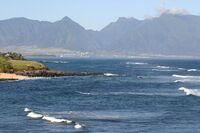Earth:Puʻu Kukui
| Pu'u Kukui | |
|---|---|
 Pu'u Kukui as seen from North Shore Maui | |
| Highest point | |
| Elevation | 5,788 ft (1,764 m) [1] |
| Prominence | 5,668 ft (1,728 m) [1] |
| Listing |
|
| Coordinates | [ ⚑ ] : 20°53′26″N 156°35′11″W / 20.89056°N 156.58639°W [1] |
| Geography | |
Lua error in Module:Location_map at line 522: Unable to find the specified location map definition: "Module:Location map/data/Hawaii" does not exist.
| |
| Location | Maui, Hawaiʻi, United States |
| Parent range | Hawaiian Islands |
| Topo map | USGS Lahaina |
| Geology | |
| Age of rock | <1.3 Mega-annum |
| Mountain type | Eroded shield volcano |
| Volcanic arc/belt | Hawaiian–Emperor seamount chain |
| Climbing | |
| Easiest route | Hike |
Puʻu Kukui is a mountain peak in Hawaiʻi. It is the highest peak of Mauna Kahalawai (the West Maui Mountains). The 5,788-foot (1,764 m) summit rises above the Puʻu Kukui Watershed Management Area, an 8,661-acre (35.05 km2) private nature preserve maintained by the Maui Land & Pineapple Company. The peak was formed by a volcano whose caldera eroded into what is now the Iao Valley.
Puʻu Kukui is one of the wettest spots on Earth[2] and the third wettest in the state after Big Bog, Maui and Mount Waiʻaleʻale,[3] receiving an average of 386.5 inches (9,820 mm) of rain a year.[4] Rainwater unable to drain away flows into a bog. The soil is dense, deep, and acidic.[5]
Puʻu Kukui is home to many endemic plants, insects, and birds, including the greensword (Argyroxiphium grayanum), a distinctive bog variety of ʻōhiʻa lehua (Metrosideros polymorpha var. pseudorugosa)[6] and many lobelioid species. Due to the mountain peak's extreme climate and peat soil, many species, such as the ʻōhiʻa, are represented as dwarfs. Access to the area is restricted to researchers and conservationists.
See also
- List of mountain peaks of the United States
- Big Bog, Maui
- Mount Waialeale
- List of volcanoes of the United States
- List of mountain peaks of Hawaii
- List of volcanoes of the United States
- List of Ultras of Oceania
- List of Ultras of the United States
- Hawaii hotspot
- Evolution of Hawaiian volcanoes
- Hawaiian–Emperor seamount chain
References
- ↑ 1.0 1.1 1.2 "Puu Kukui, Hawaii". 2004-11-01. http://www.peakbagger.com/peak.aspx?pid=11885.
- ↑ Juvik, Sonia P. (1998). Atlas of Hawaii. University of Hawaii Press. p. 14. ISBN 978-0-8248-2125-8.
- ↑ "July 2008 Precipitation Summary". National Weather Service Forecast Office Honolulu, HI. National Oceanic and Atmospheric Administration. 2008-09-04. http://www.prh.noaa.gov/hnl/hydro/pages/jul08sum.php. "The USGS gage on Puu Kukui lived up to expectation as the second wettest spot in the state by having the second highest total of 26.67 inches (79 percent of normal) below only Mount Waialeale’s 30.30 inches."
- ↑ "NOAA Hawaiʻi rain gauge summary". Pacific Islands Water Science Center. United States Geological Survey. http://www.prh.noaa.gov/hnl/hydro/pages/data_tbl_12.html.
- ↑ Wianecki, Shannon (March 2007). "Rooted in Mystery". Maui Nō Ka ʻOi Magazine 11 (2). http://www.nokaoimagazine.com/Features/v.11n.2/Rooted_in_Mystery.html. Retrieved 2008-05-20.
- ↑ Percy, Diana M.; Adam M. Garver; Warren L. Wagner; Helen F. James; Clifford W. Cunningham; Scott E. Miller; Robert C. Fleischer (2008). "Progressive island colonization and ancient origin of Hawaiian Metrosideros (Myrtaceae)". Proceedings of the Royal Society B 275 (1642): 1479–90. doi:10.1098/rspb.2008.0191. PMID 18426752. PMC 2602662. http://www.biology.duke.edu/cunningham/pdfs/PercyMetrosideros2008.pdf.
External links
 |

